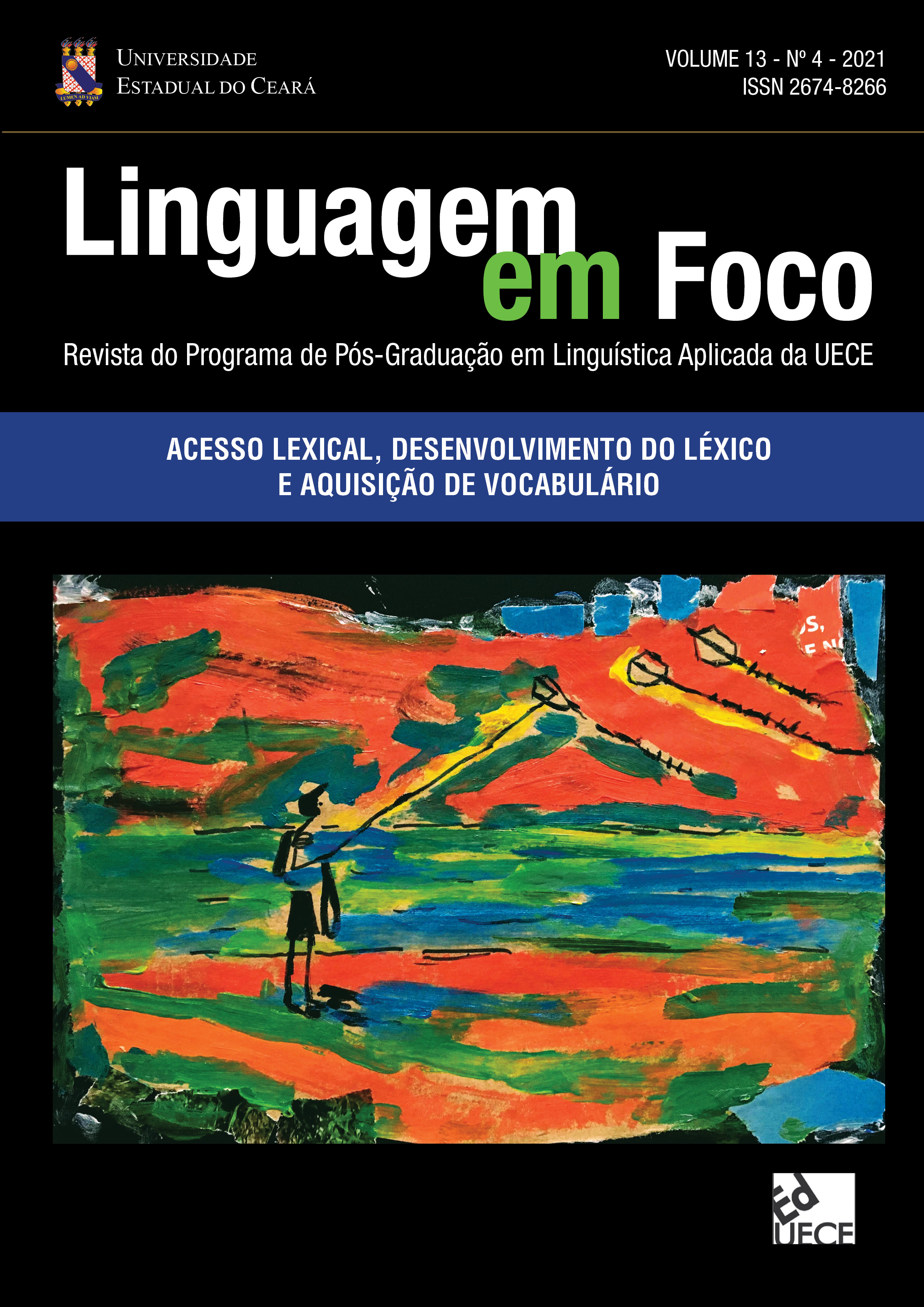Lexical access of Brazilian Portuguese
English interlinguistic homograph words in a linguistic decision and translation task
DOI:
https://doi.org/10.46230/2674-8266-13-7368Keywords:
Lexical Access, Bilingual Lexicon, Interlinguistic Homographs, Priming, Translation and CognitionAbstract
Lexical access can be defined as the search for correspondence between a word and its meaning. In this article, we present the results of a study that investigated lexical access of interlingual homographs, with the following objectives: 1) Identify whether there is a difference in the cost of processing of interlingual homographs, Brazilian-English, and words that were not interlingual homographs in a language decision task; 2) Identify the effects of repetition priming of interlingual homographs and words that were not interlingual homographs in a translation task. Through a quantitative experimental methodology in real time, online, we obtained information on the response time and accuracy of the 23 participants who performed the language decision task (Experiment 1) and the translation task (Experiment 2) in the PsyToolkit software (STOET, 2010, 2017). The results of Experiment 1 showed a significant difference between the mean response time of control words in English in relation to homographic words and control words in Brazilian Portuguese. In Experiment 2, the results showed that there was a repetition priming effect for the “old” control words (CW). These results demonstrate a higher cost of processing for interlingual homographs in bilingual lexical access, contributing to the understanding of the organization and the processing of the mental lexicon of bilinguals.
Downloads
References
ANGELE, Bernhard et al. Trilingual reading: The effect of cognates, false friends, and language proficiency, 2019. Alicante, Spain. Evento: 20th European Conference on Eye Movements.
ARAÚJO, Luciana Kuchenbecker. Palavras homógrafas. Goiânia: Brasil Escola, 2021. Disponível em: https://brasilescola.uol.com.br/gramatica/palavras-homografas.htm. Acesso em: 21 fev. 2021.
BATISTA, Amanda Aparecida de Sousa. O efeito de falsos cognatos português-inglês em uma tarefa de decisão linguística. Em elaboração. TCC (Graduação) – Curso de Letras – Inglês, Universidade Federal do Ceará.
BEAUVILLAIN, Cécile; GRAINGER, Jonathan. Accessing Interlexical Homographs: Some Limitations of a Language-Selective Access. Laboratoire de Psychologie Expérimentale, Université René Descartes et EPHE, Unité associée au CNRS 316. Journal of Memory and Language, Amsterdam, v. 26, n. 6, p. 658-672, Dec. 1987.
CARL, Michael; SCHAEFFER, Moritz. Outline for a Theoretical Model of Machine Translation Post-editing. In: LI, Defeng; LEI, Victoria Lai Cheng; HE, Yuanjian (ed.). Researching Cognitive Processes of Translation. Singapore: Springer, 2019. (New Frontiers in Translation Studies).
DAVIES, Mark. The Corpus of Contemporary American English (COCA). 2008. Disponível em: https://www.english-corpora.org/coca/. Acesso em: 21 ago. 2020.
DE GROOT, M. B. Annete; DELMAAR, Philip; LUPKER, Stephen J. The processing of interlexical homographs in translation recognition and lexical decision: Support for non-selective access to bilingual memory. The Quarterly Journal of Experimental Psychology Section A, London, v. 53, n. 2, May 2000, p. 397-428.
DIJKSTRA, T. et al. More on interlingual homograph recognition: language intermixing versus explicitness of instruction. Bilingualism: Language and Cognition, v.3, n.1, 2000, p. 69–78.
DIJKSTRA, Ton; VAN HEUVEN, Walter J. B. The Architecture of the Bilingual Word Recognition System: From Identification to Decision. Bilingualism: Language and Cognition, v. 5, n. 3, p. 175-197, 2002.
DIJKSTRA, T. O. N.; VAN JAARSVELD, H. E. N. K.; BRINKE, S. J. Interlingual homograph recognition: Effects of task demands and language intermixing. Bilingualism: Language and Cognition, v.1, n.1, 1998, p. 51–66.
DOMICIANO, Regina Maria Guarnier. Investigando o processo psicolinguístico de tradução: identificação de problemas de tradução e possíveis soluções por meio de estratégias. Revista Brasileira de Linguística Aplicada, Belo Horizonte, v. 3, n. 1, p. 69-184, 2003.
DUARTE, Aline Behling; BLANK, Cíntia Ávila. A influência do priming grafo-fônico-fonológico em uma tarefa de decisão lexical em multilíngues falantes de português (L1), inglês (L2) e francês (L3). Caderno de Letras, Pelotas, n. 35, p. 13-25, set./dez. 2019.
EDTI. BoxPlot: Saiba tudo sobre o Diagrama de caixa e como interpretar esse gráfico. Campinas: EDTI, 10 set. 2019. Disponível em: https://www.escolaedti.com.br/o-que-e-um-box-plot. Acesso em: 11 mar. 2021.
ESTIVALET, Gustavo Lopez. Léxico do Português Brasileiro – LexPorBR. 2019. Disponível em: http://www.lexicodoportugues.com/. Acesso em: 21 ago. 2020.
FRANCIS, Wendy. Bilingual semantic and conceptual representation. In: KROLL, Judith F.; DE GROOT, Annette M. B. (ed.). Handbook of Bilingualism: Psycholinguistic Approaches. New York: Oxford University Press, 2005. p. 251-267.
FRANCIS, Wendy S.; GOLDMANN, Leslie L. Repetition Priming Within and Between Languages in Semantic Classification of Concrete and Abstract Words. Memory, El Paso, v. 19, n. 6, p. 653-663, 2011.
HE, Yuanjian. Translating and Interpreting as Bilingual Processing: The Theoretical Framework. In: LI, Defeng; LEI, Victoria Lai Cheng; HE, Yuanjian (ed.). Researching Cognitive Processes of Translation. Singapore: Springer, 2019. p. 15-48. (New Frontiers in Translation Studies).
HSIEH M-C et al. Neural Evidence of Language Membership Control in Bilingual Word Recognition: An fMRI Study of Cognate Processing in Chinese–Japanese Bilinguals. Front. Psychol., 2021, v. 12. doi: 10.3389/fpsyg.2021.643211.
HURTADO ALBIR, Amparo; ALVES, Fábio; DIMITROVA, Birgitta Englund; LACRUZ, Isabel. A Retrospective and Prospective View of Translation Research from an Empirical, Experimental, and Cognitive Perspective: The TREC Network. Translation & Interpreting, Sydney, v. 7, n. 1, p. 5-25, 2015.
ITT – Institute for Test Results and Test Development. Leipzig: Leipzig University, 2019. Disponível em: https://itt-leipzig.de/?lang=en. Acesso em: 10 ago. 2020.
KERKHOFS R. et al. Testing a model for bilingual semantic priming with interlingual homographs: RT and N400 effects. Brain Res., Jan 2006, v. 12, p. 170-83. doi: 10.1016/j.brainres.2005.10.087.
KIM, J.; GABRIEL, U.; GYGAX, P. Testing the effectiveness of the Internet-based instrument PsyToolkit: A comparison between web-based (PsyToolkit) and lab-based (E-Prime 3.0) measurements of response choice and response time in a complex psycholinguistic task. PLoS ONE, San Francisco, v. 14, n. 9, p. 1-19, Sep. 2019.
LAMEIRA, Marina Fernandes Neves; TORRESI, Elaine Cristina de Barros; CARTHERY-GOULART, Maria Teresa. Línguas em conflito: modelos de acesso lexical a partir do input ortográfico em bilíngues e multilíngues e o efeito do multilinguismo sobre as funções executivas. Cadernos de Tradução, Florianópolis, v. 40, n. esp. 2, p. 185-216, set./dez. 2020.
LEE, Yoonhyong; JANG, Euna; CHOI, Wonil. L2-L1 Translation Priming Effects in a Lexical Decision Task: Evidence From Low Proficiency Korean-English Bilinguals. Frontiers in Psychology, Pully, v. 9, p. 1-10, 2018.
LEMHÖFER, Kristin; DIJKSTRA, Ton. Recognizing Cognates and Interlingual Homographs: Effects of Code Similarity in Language-Specific and Generalized Lexical Decision. Memory & Cognition, Austin, v. 32, n. 4, p. 533-550, 2004.
LINGUEE. Dicionário Inglês-Português e buscador de traduções. Disponível em: https://www.linguee.com.br/ingles-portugues. Acesso em: 21 ago. 2020.
MAIER, Robert M.; PICKERING, Martin J.; HARTSUIKER, Robert J. Does Translation Involve Structural Priming? The Quartely Journal of Experimental Psychology, London, v. 70, n. 8, p. 1575-1589, Aug. 2017.
MARQUES, Amadeu; DRAPER, David. Dicionário Inglês-Português/Português-Inglês. São Paulo: Ática, 1997.
MEDLER, D. A.; BINDER, J. R. LANGUAGE IMAGING LABORATORY. MCWord: An On-Line Ortographic Database of the English Language. Wisconsin: Medical College of Winsconsin, 2019. Disponível em: http://www.neuro.mcw.edu/mcword/. Acesso em: 21 ago. 2020.
NOGUEIRA, Zaine Martins. The effect of English- Portuguese cognates in a language decision task Em elaboração. TCC (Graduação) – Curso de Letras – Inglês, Universidade Federal do Ceará
OLIVEIRA, Bruno; FARIA, Bruna. Como interpretar uma análise de variância ANOVA? 19 ago. 2019. Belo Horizonte: Oper, 2019. Disponível em: https://operdata.com.br/blog/como-interpretar-analise-de-variancia-anova/. Acesso em: 22 mar. 2021.
OXFORD English Dictionary. Oxford: Oxford University Press, 2009.
PITZER, Keith D.; DAGENBACH, Dale. A Constraint on Eliminating Semantic Priming by Repeating a Prime. The American Journal of Psychology, Urbana, v. 114, n. 1, p. 43-53, Spring 2001.
POORT, E. V. A. D., WARREN, J.; RODD, J. Recent experience with cognates and interlingual homographs in one language affects subsequent processing in another language. Bilingualism: Language and Cognition, v.19, n.1, 2016, p.206–212.
PORTAL ACTION. Estatcamp - Consultoria Estatística e Qualidade. 2003. Disponível em: http://www.portalaction.com.br/inferencia/64-teste-de-shapiro-wilk. Acesso em: 22 mar. 2021.
RUMELHART, David E.; MCCLELLAND, James L. An interactive activation model of context effects in letter perception: II. The contextual enhancement effect and some tests and extensions of the model. Psychological Review, Washington, v. 89, n. 1, p. 60-94, 1982.
STOET, Gijsbert. PsyToolkit: A Novel Web-Based Method for Running Online Questionnaires and Reaction-Time Experiments. Teaching of Psychology, Columbia, v. 44, n. 1, p. 24-31, 2017.
STOET, Gijsbert. PsyToolkit: A Software Package for Programming Psychological Experiments Using Linux. Behavior Research Methods, Austin, v. 42, n. 4, p. 1096-1104, 2010.
TOASSI; Pâmela Freitas Pereira; CARTHERY-GOULART, Maria Teresa. Frequency effects in a language decision task containing Portuguese-English interlingual homographs. Em elaboração.
VANDEPITTE, Sonia; JOOKEN, Lieve; MAIER, Robert M.; ZHENG, Binghan. Linguistics. In: D’HULST, Lieven; GAMBIER, Yves (ed.). A History of Modern Translation Knowledge. Amsterdam: John Benjamins, 2018. p. 357-366.
VANLANGENDONCK, F. et al. Mixing the stimulus list in bilingual lexical decision turns cognate facilitation effects into mirrored inhibition effects. Bilingualism: Language and Cognition, v.23, n.4, 2020, p.836–844.
Published
How to Cite
Issue
Section
License
Copyright (c) 2022 Liana Maria da Silva Gadelha, Pâmela Freitas Pereira Toassi

This work is licensed under a Creative Commons Attribution 4.0 International License.
Authors who publish in Linguagem em Foco Scientific Journal agree to the following terms:
- Authors retain the copyright and grant the journal the right of first publication. The articles are simultaneously licensed under the Creative Commons Attribution License which allows sharing the work with an acknowledgement of its authorship and initial publication in this journal.
- The concepts issued in signed articles are the absolute and exclusive responsibility of their authors. Therefore, we request a Statement of Copyright, which must be submitted with the manuscript as a Supplementary Document.
- Authors are authorized to make the version of the text published in Linguagem em Foco Scientific Journal available in institutional repositories or other academic work distribution platforms (ex. ResearchGate, Academia.edu).





























